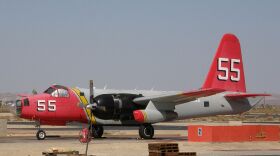Taking part in a wildfire preparation exercise called 鈥淏roken Arrow,鈥� crews from dozens of fire departments converged on the Budweiser Events Center in Loveland Tuesday. The exercise was designed to simulate 30 firefighting crews from multiple Front Range communities traveling to a centralized staging location within 90 minutes in the event of a large wildfire.
Mike Morgan, president of the , said preparing now for a large deployment by multiple communities will make a difference when a large wildfire actually occurs.
鈥淓very fire department within 90 minutes of you would deploy some resource, more automatic deployment to the staging area obviously, versus the more traditional approach of 鈥榟ey, I鈥檓 here, it鈥檚 bad, and I need help,鈥� 鈥� Morgan said.
30-90-90 Is The Mantra
A similar training exercise was conducted in Douglas County May 3. Morgan said the mantra that he鈥檚 trying to instill in the agencies participating in the exercise is 30-90-90. 30 pieces of firefighting equipment ready and at a centralized staging area in 90 minutes from time called, 90 percent of the time.
鈥淲e鈥檝e got representatives from local government, state government, federal government and they鈥檙e all here looking at it,鈥� Morgan said. 鈥淭his is the second time we鈥檝e done it, we鈥檙e learning as we go. We鈥檝e made some adjustments from the first one. We will also make some more adjustments from this one today. But we鈥檙e looking for more collaboration and partnerships. Looking outside the box a bit.鈥�

The coordinated effort is part of a larger movement to synchronize multiple agencies when attacking wildfires. This past March, the Colorado National Guard teamed up with state and local firefighters to train for over Chatfield Reservoir in Denver. And the recent creation of a will allow Colorado to partner with the U.S. Forest Service and its air tanker fleet.
All groups say the need to strengthen partnerships and mutual aid became increasingly apparent after back to back years of large destructive wildfires.
Doing Something Different To Make A Difference
Fire Crews from as far away as Aurora鈥檚 Buckley Air Force base took part in the Broken Arrow exercise. Representatives from the Western Slope also observed Broken Arrow to see if it could work in their communities. Mark Miller, chief of the Vail Fire Department said the ultimate goal of the exercise is to make it usable statewide.
鈥淵ou typically can鈥檛 amass this amount of equipment in such a short amount of time on a big fire,鈥� Miller said. 鈥淪o that鈥檚 why we鈥檙e doing something different, we鈥檙e doing these exercises to say 鈥榗an we get this many pieces of equipment in a short period of time.鈥� If we can, it may make the difference in some of these big fires to call in the cavalry instead of waiting two or three days and taking resources from further away.鈥�
There are multiple processes already in place that position firefighters and their equipment during a fire. But Miller said the 鈥淏roken Arrow鈥� effort is based off a concept of automatic local mutual aid and resource mobilization so local departments can work together to get to a fire location as fast as possible in conjunction with state and federal resources.
While the term 鈥淏roken Arrow鈥� can mean an accidental nuclear incident, it also was used during the Vietnam War as a distress call for when troops were in imminent danger of being overrun.














